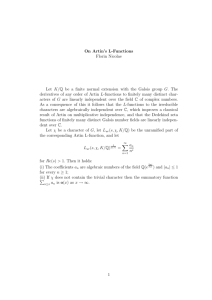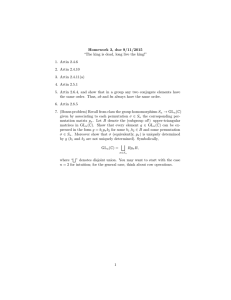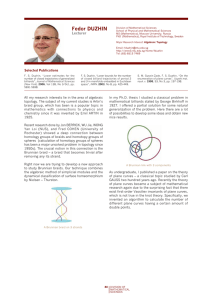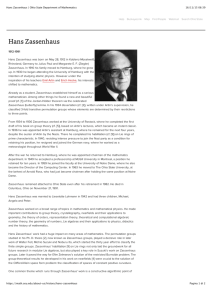Summer Research Summary
advertisement
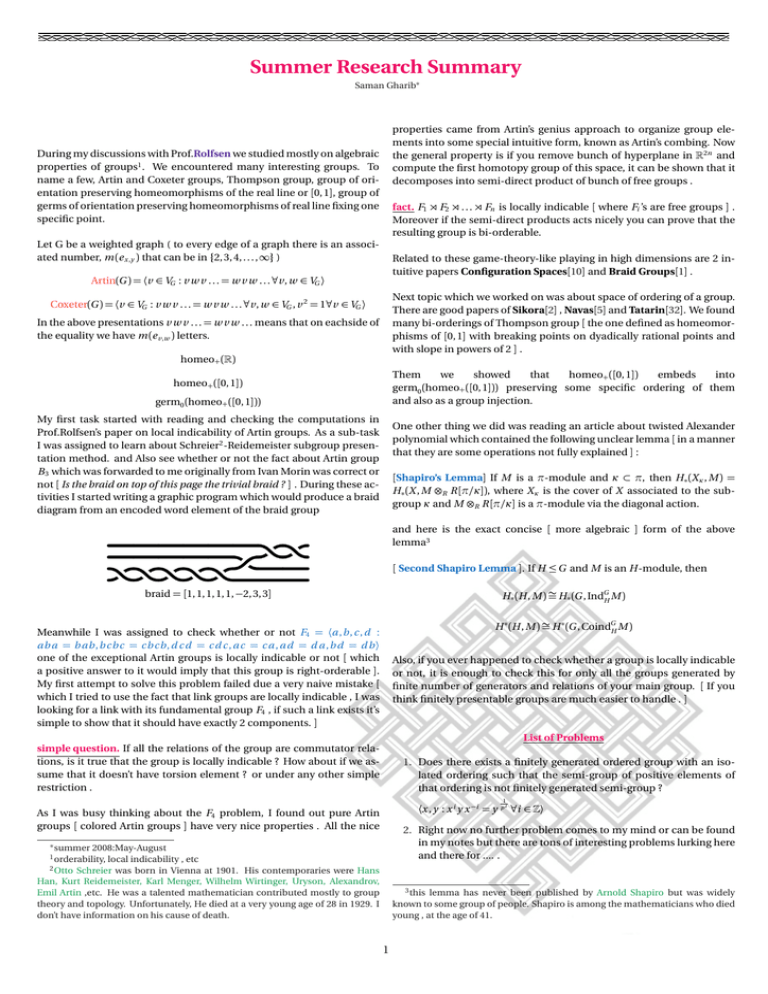
Summer Research Summary
Saman Gharib∗
properties came from Artin’s genius approach to organize group elements into some special intuitive form, known as Artin’s combing. Now
the general property is if you remove bunch of hyperplane in R2n and
compute the first homotopy group of this space, it can be shown that it
decomposes into semi-direct product of bunch of free groups .
During my discussions with Prof.Rolfsen we studied mostly on algebraic
properties of groups1 . We encountered many interesting groups. To
name a few, Artin and Coxeter groups, Thompson group, group of orientation preserving homeomorphisms of the real line or [0, 1], group of
germs of orientation preserving homeomorphisms of real line fixing one
specific point.
fact. F1 o F2 o . . . o Fn is locally indicable [ where Fi ’s are free groups ] .
Moreover if the semi-direct products acts nicely you can prove that the
resulting group is bi-orderable.
Let G be a weighted graph ( to every edge of a graph there is an associated number, m (e x ,y ) that can be in {2, 3, 4, . . . , ∞} )
Related to these game-theory-like playing in high dimensions are 2 intuitive papers Configuration Spaces[10] and Braid Groups[1] .
Artin(G ) = ⟨v ∈ VG : v w v . . . = w v w . . . ∀v, w ∈ VG ⟩
Next topic which we worked on was about space of ordering of a group.
There are good papers of Sikora[2] , Navas[5] and Tatarin[32]. We found
many bi-orderings of Thompson group [ the one defined as homeomorphisms of [0, 1] with breaking points on dyadically rational points and
with slope in powers of 2 ] .
Coxeter(G ) = ⟨v ∈ VG : v w v . . . = w v w . . . ∀v, w ∈ VG , v 2 = 1∀v ∈ VG ⟩
In the above presentations v w v . . . = w v w . . . means that on eachside of
the equality we have m (e v,w ) letters.
homeo+ (R)
Them
we
showed
that
homeo+ ([0, 1])
embeds
into
germ0 (homeo+ ([0, 1])) preserving some specific ordering of them
and also as a group injection.
homeo+ ([0, 1])
germ0 (homeo+ ([0, 1]))
My first task started with reading and checking the computations in
Prof.Rolfsen’s paper on local indicability of Artin groups. As a sub-task
I was assigned to learn about Schreier2 -Reidemeister subgroup presentation method. and Also see whether or not the fact about Artin group
B 3 which was forwarded to me originally from Ivan Morin was correct or
not [ Is the braid on top of this page the trivial braid ? ] . During these activities I started writing a graphic program which would produce a braid
diagram from an encoded word element of the braid group
One other thing we did was reading an article about twisted Alexander
polynomial which contained the following unclear lemma [ in a manner
that they are some operations not fully explained ] :
[Shapiro’s Lemma] If M is a π-module and κ ⊂ π, then H ∗ (X κ , M ) =
H ∗ (X , M ⊗R R[π/κ]), where X κ is the cover of X associated to the subgroup κ and M ⊗R R[π/κ] is a π-module via the diagonal action.
and here is the exact concise [ more algebraic ] form of the above
lemma3
[ Second Shapiro Lemma ]. If H ≤ G and M is an H -module, then
G
H ∗ (H , M ) ∼
= H ∗ (G , IndH M )
braid = [1, 1, 1, 1, 1, −2, 3, 3]
G
H ∗ (H , M ) ∼
= H ∗ (G , CoindH M )
Meanwhile I was assigned to check whether or not F4 = ⟨a ,b, c , d :
a b a = b a b,b cb c = cb cb, d c d = c d c , a c = c a , a d = d a ,b d = d b ⟩
one of the exceptional Artin groups is locally indicable or not [ which
a positive answer to it would imply that this group is right-orderable ].
My first attempt to solve this problem failed due a very naive mistake [
which I tried to use the fact that link groups are locally indicable , I was
looking for a link with its fundamental group F4 , if such a link exists it’s
simple to show that it should have exactly 2 components. ]
Also, if you ever happened to check whether a group is locally indicable
or not, it is enough to check this for only all the groups generated by
finite number of generators and relations of your main group. [ If you
think finitely presentable groups are much easier to handle . ]
List of Problems
simple question. If all the relations of the group are commutator relations, is it true that the group is locally indicable ? How about if we assume that it doesn’t have torsion element ? or under any other simple
restriction .
1. Does there exists a finitely generated ordered group with an isolated ordering such that the semi-group of positive elements of
that ordering is not finitely generated semi-group ?
⟨x , y : x i y x −i = y
As I was busy thinking about the F4 problem, I found out pure Artin
groups [ colored Artin groups ] have very nice properties . All the nice
1
pi
∀i ∈ Z⟩
2. Right now no further problem comes to my mind or can be found
in my notes but there are tons of interesting problems lurking here
and there for .... .
∗ summer 2008:May-August
1 orderability, local
indicability , etc
Schreier was born in Vienna at 1901. His contemporaries were Hans
Han, Kurt Reidemeister, Karl Menger, Wilhelm Wirtinger, Uryson, Alexandrov,
Emil Artin ,etc. He was a talented mathematician contributed mostly to group
theory and topology. Unfortunately, He died at a very young age of 28 in 1929. I
don’t have information on his cause of death.
2 Otto
3 this lemma has never been published by Arnold Shapiro but was widely
known to some group of people. Shapiro is among the mathematicians who died
young , at the age of 41.
1
[13] Egbert Brieskorn. Sur les groupes de tresses (d’apres V.I. Arnol’d), volume 1971/1972 of
Lecture notes in Mathematics. J. Wiley, University of California, 1974.
[14] Egbert Brieskorn and Kyoji Saito. Artin-Gruppen und Coxeter-Gruppen. Inventiones
Mathematicae, 17:245–271, 1972.
[15] Egbert R. Van Kampen. On some lemmas in the theory of groups. American Journal of
Mathematics, 55(1/4):268–273, 1933.
embedding homeo+ ([0, 1]) in germ0 (homeo+ ([0, 1]))
[16] Egbert R. Van Kampen. On the fundamental group of an algebraic curve. American
Journal of Mathematics, 55(1/4):255–267, 1933.
[17] Fabrizio Catanese and Marco Paluszny. Polynomial-lemniscates, trees and braids.
Topology, 30(4):623–640, 1991.
[18] George M. Bergman. Right orderable groups that are not locally indicable. Pacific
Journal Mathathematics, 147(2):243–248, 1991.
useful sources
[19] James W. Cannon, Walter R. Parry, and William J. Floyd. Notes on richard thompson’s
groups F and T. University of Minnesota.
[1]
Lee Neuwirth and Ralph Fox. The braid groups. MATHEMATICA SCANDINAVICA,
10:119–126, 1962.
[20] John Milnor. On the total curvature of knots. The Annals of Mathematics, 52(2):248–
257, 1950.
[2] Adama S. Sikora. Topology on the spaces of orderings of groups. Bulletin of the London
Mathematical Society, 36(4):519–526, 2004.
[21] John Milnor. Link groups. The Annals of Mathematics, 59(2):177–195, 1954.
[22] John R. Harper, Richard Mandelbaum. Combinatorial Methods in Topology and Algebraic Geometry: proceedings held at the University of Rochester, Rochester, New York,
June 29 -July 2, 1982. AMS Bookstore, USA, 1985.
[3] A. Dold, Beno Eckmann, editor. Séminaire Bourbaki - Exposes 400:417, volume
1971/1972 of Lecture notes in Mathematics. Springer-Verlag, Berlin, Heidelberg, New
York, 1974.
[23] Matthew G. Brin. The chameleon groups of richard j. thompson: Automorphisms and
dynamics. Publications Mathématiques de L’IHÉS, 84(1):5–33, Dec 1996.
[4] A. I. Kokorin, Valerii Matveevich Kopytov. Fully Ordered Groups. J. Wiley, University
of California, 1974.
[24] Nicolas Bourbaki. Elements of Mathematics. Lie Groups and Lie Algebras: Chapters 4-6.
Springer, 2nd edition edition, Sep 26 2008.
[5] Andres Navas-Flores. On the dynamics of (left) orderable groups, July 2008.
[6] A. V. Zenkov. On groups with infinitely many right orders. Siberian Mathematical Journal, 38(1):76–77, Jan 1997.
[25] Otto Schreier. Die Untergruppen der frien Gruppen ( On subgroups of free groups ).
Abhandlungen aus dem Mathematischen Seminar der Universität Hamburg ( Lectures
of the mathematics seminar of University of Hamburg ), 5:161–183, 1927.
[7] Bernhard Beham and Karl Sigmund. A short tale of two cities: Otto Schreier and the
Hamburg-Vienna connection. MATHEMATICAL INTELLIGENCER, 30(3):27–35, SUM
2008.
[26] Pierre de La Harpe. Topics in Geometric Group Theory. University of Chicago Press,
2000.
[27] Pierre Deligne. Les immeubles des groupes de tresses généralisés. Inventiones Mathematicae, 17(4):273–302, Dec 1972.
[8] Deborah Louise Goldsmith. Homotopy of Braids - In answer to a question of E. Artin,
volume 375 of Lecture Notes in Mathematics, pages 91–96. 1974.
[28] Étienne Ghys. Groups acting on the circle.
47(3/4):329–408, Dec 2001.
[9] E.A. Gorin and V.J. Lin. Algebraic equations with continuous coefficients and some
porblems of algebraic theory of braids. Mathematics of the USSR - Sbornik, 7(4):569–
596, 1969.
ENSEIGNEMENT MATHEMATIQUE,
[29] Vladimir I. Arnol’d ( Dimka ). The cohomology ring of the colored braid group. Mathematical Notes, 2:138–140, 1969.
[10] Edward Fadell and Lee Neuwirth. Configuration Spaces. MATHEMATICA SCANDINAVICA, 10:111–118, 1962.
[30] V. M. Tararin. On groups admitting finitely many right orderings. Dep. VINITI, 1987.
[31] V. M. Tararin. On the theory of right orderable groups. Mathematical Notes, 54(2):833–
834, Aug 1993.
[11] Egbert Brieskorn. Singular elements of semi-simple algebraic groups. In proceedings
of ICM, volume 2, Nice, 1970.
[32] V. M. Tararin. On convex subgroups of right-ordered groups. Siberian Mathematical
Journal, 35(5):1036–1039, Sep 1994.
[12] Egbert Brieskorn. Die Fundamentalgruppe des Raumes der regulären Orbits einer
endlichen komplexen Spiegelungsgruppe. Inventiones Mathematicae, 12:57–61, 1971.
[33] Wilhelm Magnus, Abraham Karrass, and Donald Solitar. Combinatorial group theory:
Presentations of groups in terms of generators and relations. Interscience Publishers
[John Wiley and Sons, Inc.], New York-London-Sydney, 1966.
The blue diagram above represents graphically an action of a group on another group such that the whole systems makes a bigger group.
2
